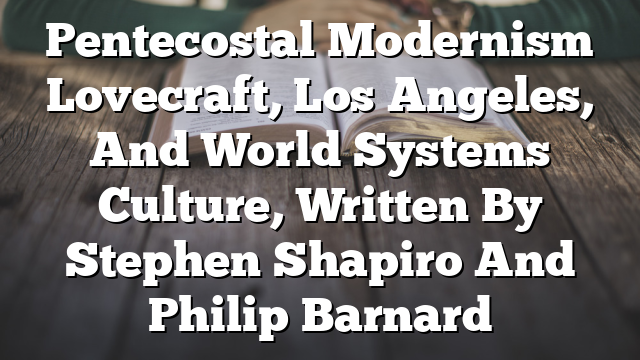Click to join the conversation with over 500,000 Pentecostal believers and scholars
Click to get our FREE MOBILE APP and stay connected
| PentecostalTheology.com



book reviews
385
Stephen Shapiro and Philip Barnard
Pentecostal Modernism: Lovecraft, Los Angeles, and World-Systems Culture(London,
uk: Bloomsbury Academic, 2017). 184pp. $85.36 hardcover.
Pentecostal Modernism: Love Craft, Los Angeles, and World-Systems Culture is a literary study co-authored by English professors, Stephen Shapiro and Philip Bernard. The primary goal is to challenge traditional histories of Modernism as a secular movement limited to metropolitan cities like Paris and London. Therefore, central to this work is the desire to depict Modernism and religion as “inescapably interwoven” (8) and to prove that regional cities—like Topeka, Kansas, Rochester, New York, and Providence, Rhode Island—also informed mass culture.
PentecostalModernismis organized into five chapters, divided into two parts. Each chapter builds upon the other while moving between literary theory, his- tory, and cultural studies. Partasets out to remap Modernism and to introduce Leon Trotsky’s “combined and uneven development.” The authors use this ana- lytical instrument to grasp the dynamics of the capitalist world-system and to calibrate the current modernist narrative to include those people and places on the semi-periphery. Part a also unpacks how semi-peripheral groups in the throes of Modernism experienced frustration when their expectations to par- take in the “benefits of the boom” (145) went unfulfilled. Ultimately, Partalays the foundation for the authors’ analysis of groups on the socioeconomic semi- periphery and their tendency to create new social realities by reclaiming and reinventing older and often obsolete traditions and practices.
Part b opens with Chapter three, “Pentecostalism and the protolanguage of racial equality.” Using Trotsky’s combined and uneven development and Thomas Szasz’s notion of protolanguage, Shapiro and Barnard revisit the his- tories of Azusa and find “the explosive rise of American Pentecostalism and speaking-in-tongues as the constitutive phenomenon of a semi-peripheral Modernism that allowed … a pre-emergent experience to become apparent and almost instantly ubiquitous, once it had found a tenable form (speaking in tongues) that could bear and convey its social energies” (51). Inevitably, the act of speaking in tongues becomes the focus, particularly the ways in which the practice reflects (1) early Pentecostalism’s use of the Book of Acts to recon- struct foundational aspects of biblical Christianity and (2) its unique ability to bring people together and to “enact the movement’s commitment to over- coming racial distinctions” (62). The second point highlights the importance of race in both this chapter and the overall text. As such, Black Americans who attended Azusa function as exemplars of what it means to grapple with expec- tation and frustration within a combined and uneven development. There-
© koninklijke brill nv, leiden, 2017 | doi: 10.1163/15700747-03903024
1
386
book reviews
fore, for Shapiro and Barnard it is important to construe Black Pentecostals’ encounter with early Pentecostalism as being less about personal holiness and more about power to overcome injustice and oppression.
Furthermore, Shapiro and Barnard claim that thinking of early Pentecostal- ism as “a vision of those obstructed from entering the fold” (101), rather than as the “disinherited,” gives tongues new significance, especially when enacted in corporate worship. According to Shapiro and Barnard, during the shared prac- tice of speaking in tongues, early Pentecostals constructed “new and otherwise improbable alliances that [allowed] them a better base from which to leap for- ward” from social obstruction to incorporation (101). Moreover, Shapiro and Barnard claim that tongues enabled early Pentecostals to speak “an inconve- nient truth in a protected fashion” (103). Thereby constituting what the authors refer to as semi-peripheral speech. As semi-peripheral speech, speaking in tongues enacts an experience-system wherein practitioners assert a certain agency that not only feels (has an affective encounter) but informs (makes the problem known), and promotes (demands intervention and positive out- comes).
Chapters four and five treat two additional modernist productions: pulp fiction and the Social Gospel. Chapter four examines the 1920–1930s, the period of institutionalization for American Pentecostalism. However, its focus is on H.P. Lovecraft’s pulp fictions and his use of semi-peripheral speech to initiate a veiled discussion on race and the prejudicial exploitative practices of higher cultural institutions. Chapter five presents a brief afterword on the Social Gospel, Modernism, and Pentecostalism. Here, the authors note that despite their theological, social, and political differences Pentecostalism and the Social Gospel agreed that, “something is wrong with the nation and the world” (147). Although the two groups differed about how to remedy this “wrong,” it remains that they, like Lovecraft, shared a deep concern about Modernism’s failure to facilitate “social and institutional incorporation” for everyone (162).
The brevity of Pentecostal Modernism belies its density, but not its accessi- bility. In fact, it is an enjoyable read that is both insightful and well-researched. Indeed, because the authors critically engage with a host of scholarly resources, the text includes an extensive bibliography, given its size. Pentecostal Mod- ernism is not a theological work. However, Shapiro and Barnard’s conclusions about the corporate practice of speaking in tongues as part of a complex experience-system is a welcomed contribution to Pentecostal scholarship. For although the authors do not make the claim themselves, their conclusion(s) about Pentecostal spirituality offers Pentecostal scholarship yet another way of talking about Pentecostalism as a prophetic tradition of prayer (praise) and protest.
PNEUMA 39 (2017) 365–424
2
book reviews
387
Pentecostal Modernismis an important work on the social factors that played a critical role in the rise of Pentecostalism, its practices, and its identity. As noted above, the authors are not Pentecostal scholars and the central goal of their project is not the advancement of Pentecostal scholarship, proper. Nevertheless, it is concerning that Shapiro and Barnard used Pentecostalism, its practitioners, and its practices to make claims about social and institutional incorporation without offering first-hand accounts to support their claims. In other words, it is not clear from the text which primary source documents the authors used to definitively conclude that Pentecostals: (1) felt frustrated with their socioeconomic position, (2) understood tongues as little more than either the airing of grievances or the catalyst of a new social order, or (3) understood themselves as being woefully semi-peripheral to the advancing culture. Without such first-hand accounts, it is hard to determine the fairness and accuracy of Shapiro and Barnard’s conclusions.
Given the historical and theoretical work included in Pentecostal Modern- ism, graduate students and specialists with scholarly interests in the related subject matter would benefit most from reading this text.
Dara Coleby Delgado University of Dayton, Dayton, Ohio
delgadod1@udayton.edu
PNEUMA 39 (2017) 365–424
3


